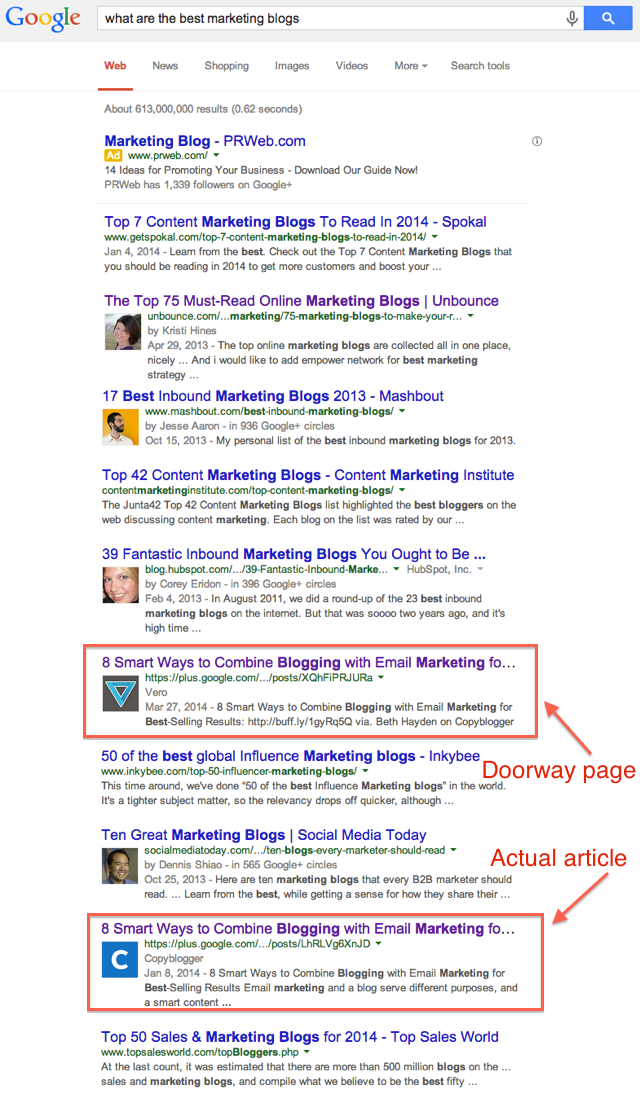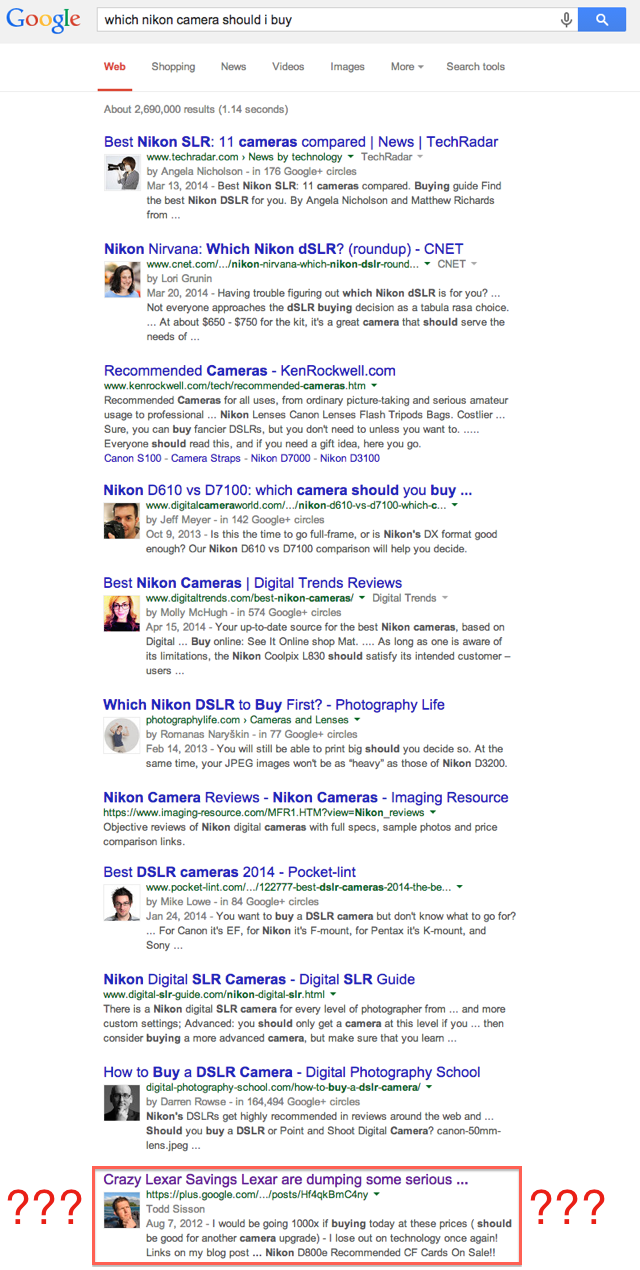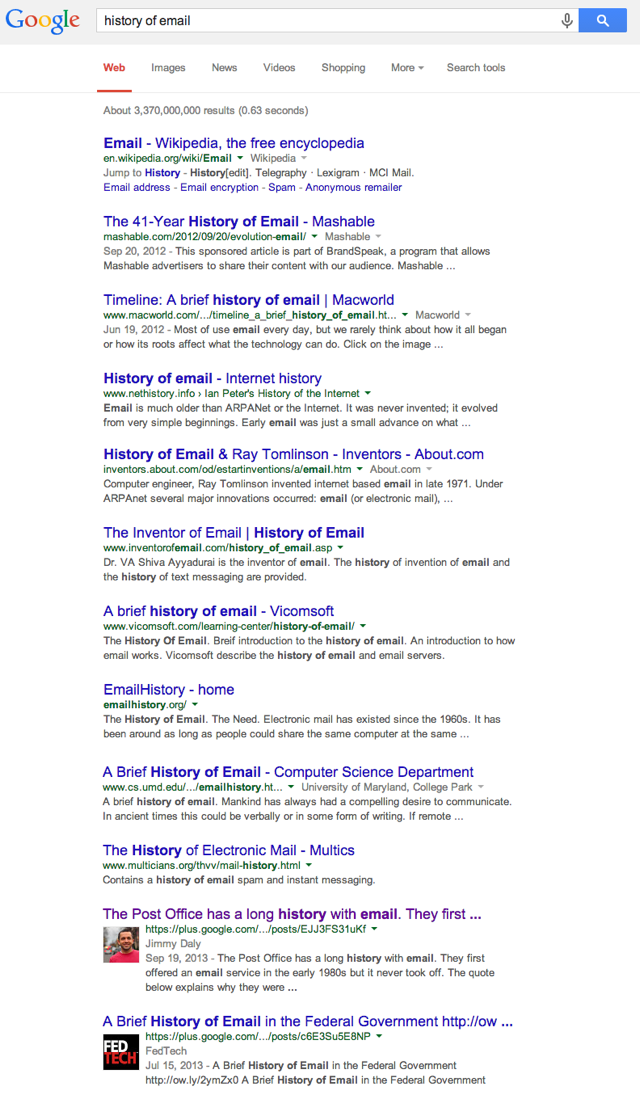Why It’s Time to Embrace Google+ Doorway Pages
-
UncategorizedUpdatedPosted:
On this page
SEO has changed a lot over the last ten years. One thing that hasn’t changed, however, is that Google reigns supreme. For all their efforts to clean up search engine result pages (SERPs), they often put their own business interests ahead of the best search results.
Look no further than Google+ for proof.
In the old days, doorway pages were a common black hat SEO technique. Doorway pages were built to rank for a keyword but sent users to a different (and often spammy) page. It was incredibly annoying for searchers but, by and large, Google has done away with them. Here’s what Matt Cutts has to say about doorway pages:
Here’s the quote I’d like to highlight:
If you look at the history of which businesses have done well over time, you’ll find the sorts of sites and the sorts of businesses that build websites that are built to stand the test of time. If someone is using a technique that is a gimmick, or the SEO fad of the day, that’s a little less likely to really work well a few years from now.
Google has been abusing it’s own rule with Google+ doorway pages.
No doubt you’ve come across these in your searches. You type in a search and your feed is filled with links to Google+ posts that link to article you actually want. You have to pass through Google+ to get the content you are looking for. Google calls this “personalization”. I call it an annoyance. But as a marketer, I must concede this a very real opportunity. First, let’s look at a few examples, then examine how to take advantage of Google+ doorway pages to get more traffic.
Example #1: Duplicate Content on SERPs
We recently published a post titled 50 Marketing Blogs You Should Read Every Day. It’s been really successful, to the tune of more than 4,000 social shares and 11,000 pageviews. So far, 336 of those shares have come from Google+ but when I search [what are the best marketing blogs], it doesn’t show up on the first page.
It was published about three weeks ago, so I can understand why
it’s not ranking well yet. The interesting thing is that Vero does
show up on the first page, except that it’s a Google+ post, which
links to a Copyblogger article. The actual Copyblogger article
also ranks, just a few spots below.

There are ten spots on the first page. Why is Google including the same article twice? Why does the Google+ doorway page rank higher than the article itself? These doorway pages are useless if the content is going to rank without Google+ anyway. I’m trying hard to not to be biased, but there is no reason for a “personalized” Google+ result in this search. And it’s not even the best result! Our list of must-read blog fulfills the search query much better, and it’s nowhere to be found.
Example #2: Utterly Useless Results
Admittedly, I have skin in the game in the last example, so let’s try one I can analyze with total objectivity. Let’s try [which nikon camera should i buy].

There are 11 results on this page. The first ten provide a useful answer to my question. But number 11 … what happened here? This is a link to a Google+ post about Lexar memory cards. It has nothing to do with buying a Nikon camera and it sends searchers to a Google+ that then directs people to the actual blog post.
To recap:
- The Google+ post isn’t a relevant search result.
- Google+ plus adds no value to the search, but gives Google+ a free pageview.
If You Can’t Beat ‘Em, Join ‘Em
Google seems to be ignoring their own advice. These doorway pages get in the way of the good stuff. But since it’s hard — or impossible — to argue with Google, why not join them?
Researching via Google for a presentation and I keep finding the content I’m looking for through what @aaronwall calls G+ doorway pages 😛
— Jon Henshaw (@RavenJon) April 16, 2014
Here’s the deal: While these pages don’t always offer the best results, sometimes they give smaller sites a chance to rank alongside — or even above — much bigger ones. Since Google+ posts are most likely to be seen by people in your circles, an influential and active Google+ user could affect a lot of search results. Here’s what I mean.

The last two results on that SERP send people to articles I’ve written on the topic. Would those articles rank alongside Wikipedia, Mashable, MacWorld and the University of Maryland without Google+? Probably not.
With that in mind, here are a few ways to use Google+ doorway pages to your advantage:
- Be active on Google+. Post content on your own account and a business account (if applicable). It’s also a good idea to post on Community pages, leave comments and tag people in your posts. Check out 29 Essential Tips from the Top Google Plus Geeks on Blog Tyrant for lots of great tips on growing a Google+ following.
- Use Authorship. In this post, we looked at three SERPS with a total of 33 results. Sixteen of those results appeared with the author’s image or the site’s logo next to it. Not only does this draw searchers’ attention, it helps Google match your content to your Google+ page. They may tell this won’t affect your ranks … choose to believe that at your own peril. Check out Jon Morrow’s awesome guide to implementing and using Authorship here.
- Write timely content. Very few sites are accepted to Google News but anyone can have a Google+ account. Google+ posts can be indexed very quickly, meaning if your site’s content is being posted to Google+ immediately, you greatly increase your chances of ranking for time-sensitive topics.
- Go head to head with the big guns. Google+ doorway pages actually allow you to compete with huge websites. In my last example, I was able to get my small website on the same page as Wikipedia and Mashable. So write like you mean it. Google is constantly experimenting with Google+. They know the results aren’t perfect but they also know that the biggest sites don’t always have the best content.
Have any other thoughts on using Google+ to boost your search traffic? Let us know in the comments.
Want to send more personalized mobile and email messages to your users?
Learn moreCustomer story

How Vero helps Plann cater to the needs of an agile startup that's scaling up quickly

